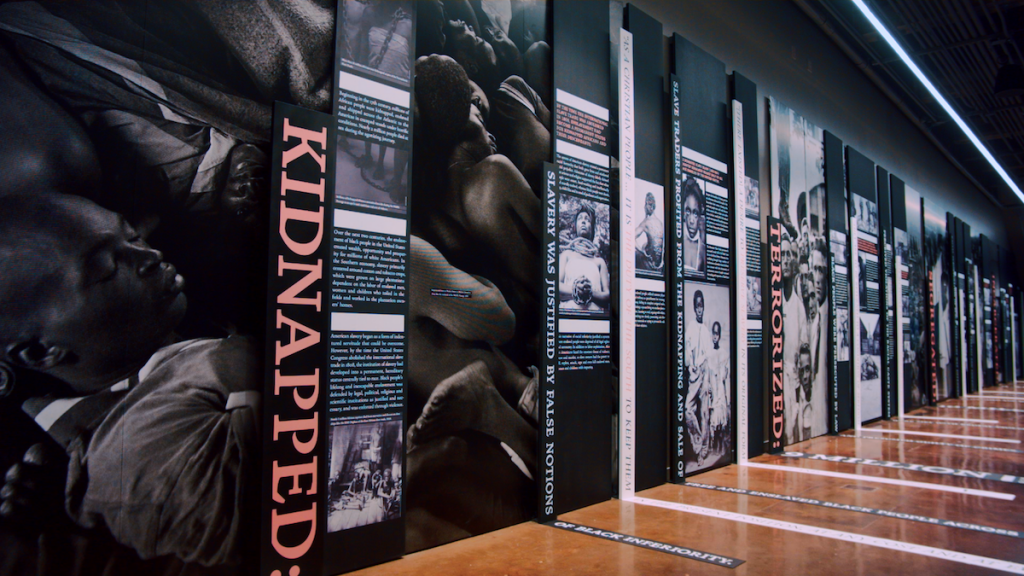Calls for truthfulness are emanating from surprising quarters these days. President Trump has motivated elites in the press and the academy to lament that truth is no longer an organizing ideal in American society. It is said that our culture and politics are post-truth.
The idea of a post-truth society moved to the front of my mind as I recently walked through the Legacy Museum. It’s a new museum in downtown Montgomery, Alabama, where I live, created and operated by the Equal Justice Initiative. EJI launched the museum and a nearby lynching memorial to document America’s history of racial injustice “from enslavement to mass incarceration.” The opening attracted national attention. Even Oprah appeared around town.
After the parade of private jets and celebrities ended, I visited the museum on a recent weekday afternoon. After paying the eight dollar admission fee, I was issued a ticket with a set time to begin my self-guided tour.
The theme of the museum is a direct line from enslavement of black human beings in the eighteenth and nineteenth centuries to the mass incarceration of black Americans in the twentieth and twenty-first centuries. That line is racism. To draw the line, the museum filters out causes of incarceration that merit attention. But this filtering enables the museum to teach an important lesson about the importance of telling the truth in a post-truth society.
Start your day with Public Discourse
Sign up and get our daily essays sent straight to your inbox.The Elaborate Narrative and the Simple Counter-Narrative
The line running through the museum is a story about a false story. The culture and economy of slavery were morally abhorrent. It involved breaking up marriages and families, perpetrating physical violence, and creating legal entitlements for some human beings to dominate the wills of other human beings. To justify the grievous injustices that slavery involved, participants in the slave-owning culture invented what the museum calls an “elaborate narrative of racial inferiority.” That narrative has shaped our laws and criminal justice institutions.
The museum draws the link between slavery and over-incarceration both experientially and rationally. Near the entrance, visitors interact with talking images of slaves behind bars. Montgomery sits on the Alabama River near the confluence of the Coosa and Tallapoosa Rivers. Owing in part to its navigable river port, Montgomery was the site of a busy slave market during the height of the Caribbean and Southern American slave trade. At the museum’s entrance, visitors stand where slaves were imprisoned while awaiting transfer to their new masters. Near the end of one’s walk through the museum, one again encounters African-Americans behind bars, this time wearing jumpsuits and speaking in contemporary idioms, describing their prison experiences.
The museum does not merely suggest the connection between slavery and mass incarceration. It makes a rational case that, though not as rigorous as an argument, provides reasons to believe there is a single thread running from antebellum slavery to contemporary mass incarceration. Call it a rational counter-narrative.
In sum, the counter-narrative boils down to this: The false narrative of racial inferiority pervaded the thinking of elite whites when slavery became most inhumane, on the eve of the Civil War. It persisted after the Civil War and survived Reconstruction. It motivated Jim Crow codes, which criminalized inherently non-culpable conduct. Its intellectual and moral effects survived even the Civil Rights movement and drove the tough-on-crime policies of the 1980s and 1990s. It continues to motivate prosecution and sentencing decisions with the result that blacks are prosecuted more often and sentenced more harshly than whites for the same crimes.
The museum’s displays assert that the Civil War amendments, Reconstruction, and the Civil Rights movement all failed to negate the false narrative of racial inferiority. Rather, the narrative survived, moving from our property and political laws and institutions into our criminal laws and institutions. The Thirteenth Amendment, which abolished slavery and involuntary servitude, makes an exception for “punishment for crime whereof the party shall have been duly convicted.” This exception has swallowed the rule, the displays suggest.
The Civil Rights Act of 1866 and the Fourteenth Amendment followed ratification of the Thirteenth Amendment, requiring equal protection of the laws and expressly forbidding that blacks be convicted of crimes except on terms equal to whites. But when Reconstruction collapsed in the 1870s, northern Republicans (the museum displays ambiguously refer to “the federal government”), who had championed abolition and civil rights, turned their attention to other things. (The exhibits do not mention the US Supreme Court’s role in gutting the Civil Rights Act of 1866 and those of 1870, 1871, and 1875.) This abandonment of southern blacks left in charge of the former slave states the very people whose moral views had been molded in the collective self-deception of racial inferiority.
There followed a second era of racial hierarchy, driven economically by new forms of bonded servitude and enforced by terror. Southern whites transformed the criminal justice system into a means of continuing the narrative of racial inferiority and reasserting the power they had lost in the Civil War. EJI has documented 4,000 lynchings between 1877 and 1950 in southern states, and hundreds elsewhere.
Lynchings were predicated on criminality. And America racialized criminality. Elaborate Jim Crow statutes made innocent conduct into criminal conduct. More recently, the war on drugs and three-strikes laws also make it criminal to be black. And, the museum displays suggest, they are designed to do so.
The Truth About Self-Deception
The museum makes the counter-narrative clear and compelling by following only one thread. As a result, it makes several omissions. (More on those below.) Nevertheless, the central insight of the counter-narrative, which the museum displays never quite articulate but which is indispensable to the counter-narrative’s power, is simply true.
That truth is that people who tell themselves that others are morally and intellectually inferior because of their race make themselves into racists. When people tell this falsehood to their children, they create a racist culture. They set out to justify their conduct and end up transforming themselves and their society. In the process, they lose awareness of what they have become. After a generation or two, they forget what they once were.
This insight rests in a more universal truth about human nature. It is that when we lie to ourselves about the moral status of other human beings, we not only unjustly injure other people, we also injure ourselves and our culture. We transform ourselves into a people who believe the lie. The costs of self-deception are internal and reflexive as well as external and consequential.
This fact about human nature is familiar to regular Public Discourse readers from the writings of philosopher and PD contributor Christopher Tollefsen. Professor Tollefsen has written here (and at article-length and book-length elsewhere) that what makes an act of lying wrong is not only the harm it causes to others but also what it does to the person who lies. Tollefsen argues that lying “divides the inner and outer self, damaging the agent’s integrity; and integrity is a great good.” It also destroys the good of sociability. It damages the trust and friendship that are so essential to a just society.
A lie not only damages the liar’s integrity and destroys his friendships, it also alienates him from the truth. And like all vices, falsity disables a person for virtue. A person willing to communicate falsehood long enough comes to believe the falsehood, and then becomes unable to believe the truth.
What the Museum Omits
EJI clearly teaches visitors to the Legacy Museum that the mass incarceration of black men today is caused by the same false narrative of racial inferiority that slave owners and traders concocted to rationalize their evil acts, and that later produced a culture of Jim Crow and lynchings. The museum omits other causes of our imprisonment epidemic. Two seem particularly worthy of consideration.
First, segregationists were not the only people to use criminal law to prohibit innocent conduct in the late nineteenth and early twentieth centuries. Architects of the progressive revolution also employed criminal law as a tool of social engineering. Like segregationists, progressives unmoored criminal law from its foundation in the law of wrongs. As a result, criminal liability is now a pervasive risk in American life.
As Justice Jackson explained in the landmark case Morissette v. United States, so-called “public welfare offenses” proliferated “to call into existence new duties and crimes,” which are not inherently culpable and “which disregard any ingredient of intent.” This over-criminalization of American life was motivated not by racism but rather by confidence in the ability of public law and government to redress the harsh effects of industrialization and crowded cities. Public welfare offenses make criminals out of Americans of all races.
Second, and more obviously, the museum omits any reference to the breakdown of the family. Evidence shows that unmarried men are at greater risk of conviction and imprisonment and that fatherless boys are much more likely to become trammeled in the criminal justice system when they mature. These tendencies also transcend race. Though out-of-wedlock births and fatherless families are more numerous in black communities, they represent large percentages of all American families. The sexual revolution and the moral hazards of government dependence seem at least as likely culprits as racism.
Why the Museum is Important
Despite those omissions, the Legacy Museum makes an important contribution to our understanding of legal and natural justice. And we should bear its lessons in mind as we move to reform our laws and institutions. Justice requires us to search our own narratives and motivations and to root out any self-deception we find. We owe it to each other and to ourselves.
The truths one encounters in the Legacy Museum are not black truths or southern truths. They are neither your truths nor my truths. They are human truths. From the Hebrew and Christian scriptures to the Declaration of Independence and the Universal Declaration of Human Rights, we find expressions of the truth that all human beings have inherent dignity and value and bear equal claims to the protection of the laws.
Adam MacLeod is a professor of law at Faulkner University’s Thomas Goode Jones School of Law, author of Property and Practical Reason, and co-editor with Robert McFarland of Foundations of Law.














